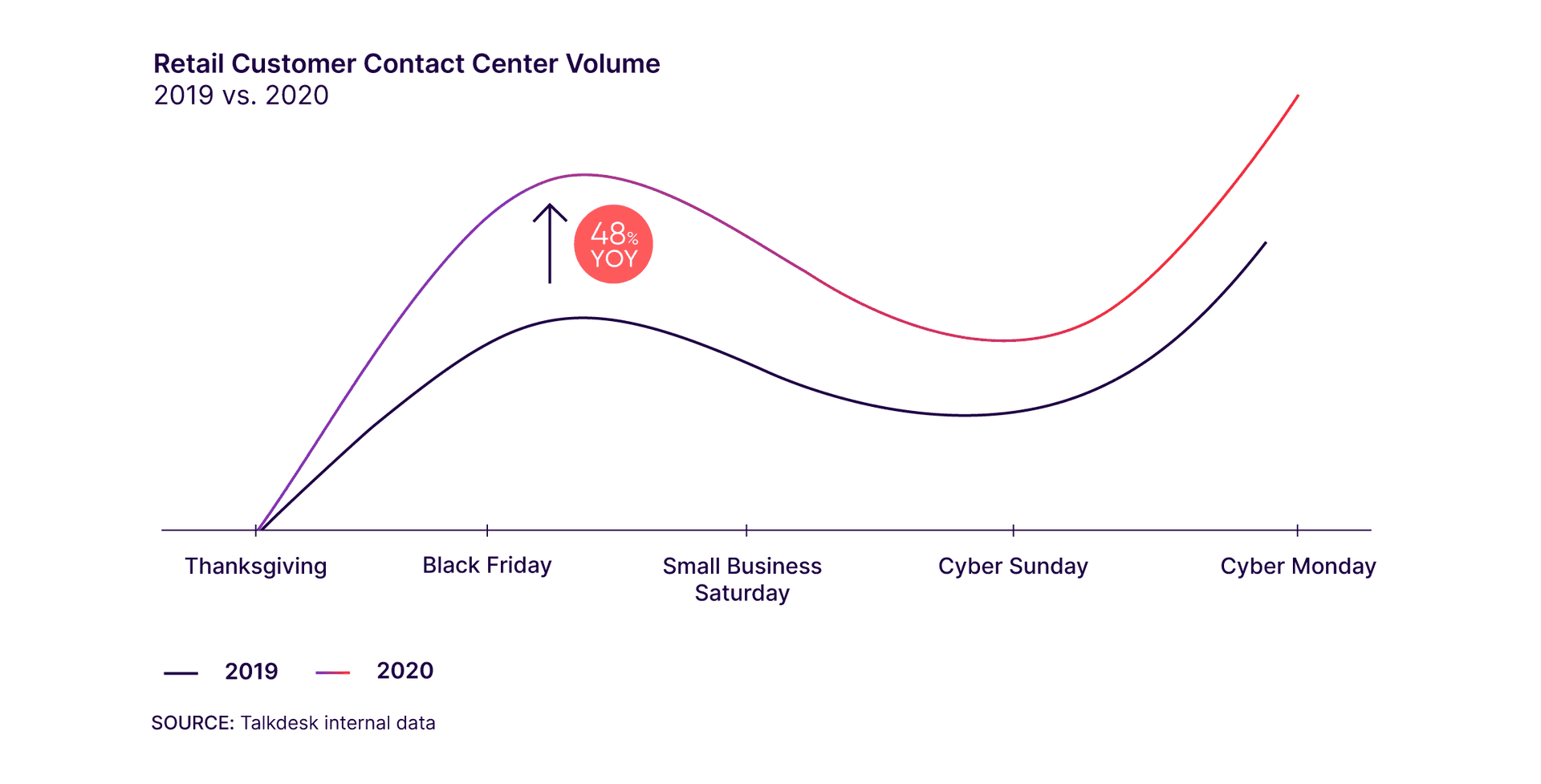How to mitigate customer service staffing shortages and shipping delays during the holidays in 2021

By Duane Peck
0 min read

This year, retailers may face customer service staffing shortages and shipping delays due to customer demand and carriers constraints. To avoid unhappy customers, retailers should carefully prepare for the holiday season.
The 2021 holiday season is shaping up to be similar, if not more difficult, than the 2020 retail holidays. Although an entire calendar year has come and gone, the underlying conditions that caused 2020’s “double holiday peak” are still in place this year.
Due to the ongoing pandemic, reliance on e-commerce remains higher than it was pre-COVID. Supply chains continue to be taxed for a variety of reasons. And global delivery carriers are forecasting that package demand will outpace their available capacity.
Let’s dive deeper a bit on each of these, and how retailers can prepare.
Customer demand and e-commerce are increasing.
As parts of the world approach pre-pandemic normalcy, consumer product demand and retail sales have rebounded. Fueled partly by widespread financial stimulus, retail sales are up significantly year over year, despite a down month in July. While customers are finding their way back to shopping in brick and mortar stores, e-commerce reached new heights during the pandemic and has sustained a level higher than its previous 2019 growth trajectory.
But for retailers, this relatively small uptick in e-commerce will play a significant role in their ability to deliver a great holiday experience for customers. Why? Because e-commerce, in general, has outsized downstream impacts.
Online shopping and fulfillment is not only more expensive for retailers, but it is also naturally much more service-intensive (with where is my order? being a top inbound issue for most retailers). We also know that, depending on the category, online purchases are up to three times more likely to be returned than items bought in physical stores.
Delivery carriers are forecasting constraints and increased costs.
Order your Christmas presents now, UPS chief says, amid supply chain drag. Headlines such as this one have become increasingly common since late summer. Just as we saw in 2020, delivery carriers are forecasting another potential “shipageddon” scenario.
Overall demand will outstrip the available capacity of the system, leaving numerous undelivered, late, and potentially lost packages. So even if products are in stock and customers can purchase the gifts they want, there’s no guarantee that they’ll receive them on time for the holiday.
Likewise, as of October 3, USPS is projecting cost increases, a potential early indicator that other carriers may follow suit. This announcement came in tandem with a projected delivery slow-down of up to 30%.
What does this mean for retailers and customer service?
The simple answer is the potential for many dissatisfied, if not angry customers. Last year, Talkdesk analyzed contact volume from a representative group of our retail customers over the “Cyber Five” holiday shopping weekend (Thanksgiving through Cyber Monday) and found a 48% total increase year-over-year in inbound contact volume.

We are anticipating similar volumes this year, driven by many of the same forces. Whether customers pick up the phone, send an email, or engage via chat or messaging, retailers should anticipate an all-hands-on-deck fourth quarter for their contact centers and customer service teams in order to properly respond to service requests and avoid customer service staffing shortages.
Inbound customer contacts will skew towards an amplified mix of the standard types of holiday inquiries: where is my order, returns for late gifts (in addition to the normal post-holiday volume), cancellations, and general outreach to clear up confusion about delays and shipping snafus.
"We don’t put people on the phone the whole day. We alternate with offline cases for people to take a breather. To be very good at your job, as an advisor, one needs to connect emotionally to the customer. "
Patrícia Loureiro Global director of customer service at Farfetch
2 tips to mitigate customer service staffing shortage this holiday season.
Talkdesk recently published a comprehensive content kit to help retailers prepare their contact centers for the holidays. But a number of the tips are applicable beyond your CX team and applicable to other areas of your business.
1. Be proactive and honest with your customers.
All good customer experiences are centered around communication. Ensure you are proactively reaching your customers and informing them of anticipated issues, or just to encourage them to start their shopping earlier than normal.
If you expect your holiday shipping cutoff dates will be earlier than normal or just want your customers to be prepared for fulfillment alternatives and higher call volumes, make sure this messaging is available early and highly visible throughout all customer touchpoints.
Take the example of Tuft & Needle—the mattress company typically adjusts service level thresholds quarter over quarter and year over year in order to raise the bar higher and provide even better experiences for their customers.
At Tuft & Needle customer service, positive agent-customer interaction is achieved by ensuring callers are routed to the right agent at the right time. Phone and email interactions are fully integrated to provide an omnichannel approach and meet customers on their preferred channel.
2. Gather all the troops to support the contact center.
Customers don’t inhabit or act in silos, so neither should your organization. The reality is that while retailers are intensely focused on digitally transforming themselves, the goal of breaking down internal barriers has not been fully realized by most.
The holidays are a great time to break down these siloes and build empathy towards your contact center. Different teams across your company can help answer calls during the rush. Not only will it be a great opportunity for employees that don’t often interact with customers to gain insight into what they’re saying and why, but it will also alleviate some of the burdens that contact center agents face during emotionally-packed times.
In an Opentalk session, Patrícia Loureiro, global director of customer service at Farfetch, shared that they take their advisors’ (customer service representatives) mental health very seriously year-round. She said, “We don’t put people on the phone the whole day. We alternate with offline cases for people to take a breather. Mental health is important. We do have a helpline, which is internal (managers and other people volunteer) and fully dedicated to the advisors, to take a moment between calls if they need to take a breather and vent. To be very good at your job, as an advisor, one needs to connect emotionally to the customer. And sometimes that can feel heavy, especially during the last year. People have been stressed and anxious, and pretty lonely as well. That is a lot. For advisors to be wonderful on each call, they need to reset. That’s what the helpline is for, to take away all of the emotion from the last customer to the next.”
As the world slowly returns to something approaching pre-pandemic normalcy, retailers will continue to face unexpected and new challenges. I encourage anyone within a retail organization to put customers and customer service agents at the forefront of their planning and execution. It may sound trite in 2021, but the reality is that it’s the only way to operate going forward. Best of luck for a successful 2021 holiday season!









